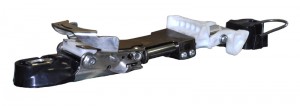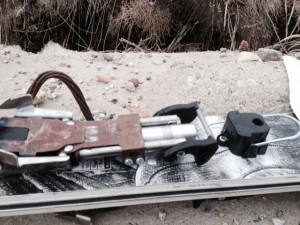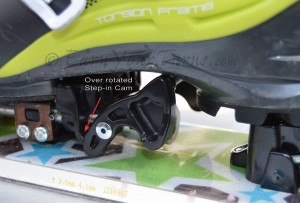The M-Equipment’s inaugural binding, Meidjo, had issues with the steel pins inside the arm springs bending. M-Equipment recognized it was a bad choice to use stainless steel for those pins, and upgraded them to a harder steel. There were other items not holding up either, or simply not working very well. Most of those items have been fixed with revisions made for S/N A00150 and up.
Fritschi had issues with their first generation of Vipec bindings like the adjustable toe pin falling out, confusion on when to adjust, or even the simple acts of getting in and out of the binding. Again, all these issues were addressed with revisions to the product, though getting in and out is still different enough from other tech toes to be problematic without practice.
Tacit Beta Bindings
What’s the common thread here? These were all first generation products sold to consumers with the implicit understanding they were tested and proven to be ready for real world abuse. Except if you look at the track record of almost any first generation backcountry binding there are more abuses of consumer confidence with first year products than there are of trouble free deliveries.
Part of that is simply because it isn’t possible for engineers to anticipate all the types and combinations of abuse a product will be subject to. And there are manufacturing issues that only become evident when you go into full scale production and things start drifting.
Which is why 22 Designs is to be commended for maintaining the beta test program they inherited when they took over production of the Hammerhead binding.
Public Beta Testing
What stood out with the Hammerhead was how well it fared compared to Black Diamond’s introduction of Ted Ayliffe’s design, the O2, which in the haste to beat the Hammerhead to market, was launched as a finished product when Rainey Designs was launching the Hammerhead. The difference was the Hammerhead was being introduced after a year of beta testing using willing, paying customers.Russell Rainey announced the basic Hammerhead concept a year earlier, and then sold 200 pairs of admittedly prototype bindings for full price, not to unwitting consumers, but to customers who were fully aware they were partners in the product’s development. By paying full price Rainey knew they would demand satisfaction, which is what he promised up front. After a full season of abuse and reports of the cable being sawed in two, being derailed, and ripping out of the ski, he knew what needed beefing up and what needed wholesale redesign. But when it came to market as a production binding it stayed nearly unchanged for a dozen years before being replaced by the Axl and Vice.
On the otherhand, BD, in trying to match the production schedule, rushed Ayliffe’s design to market. By Christmas BD announced the first official recall of a telemark binding ever. The difference was in the level of pre-production testing.
Most companies use first year consumers as their unwitting accomplices in beta testing, they just don’t admit it. Instead they cover changes under their warranty. If it’s a simple thing like pins not being properly pressing into tech toe arms, the cost and harm to a brands reputation can be small, and the recovery short. For others, the cost to fix the problem can kill the company, especially with start ups.
Status of the Outlaw Beta Test Program
22 Design’s Outlaw, an Axl for NTN tele boots is in beta test this season. There are definitely some short comings. Heck, even I broke an Outlaw and I don’t break bindings very often. Nor am I the only one.
It turns out the plastic part that hooks onto the duckbutt of a tele boot can crack and break. First generation users of the Meidjo experienced a similar issue. In both cases, the problem was the composition of the plastic, and incorrect curing. In both cases part of the fix is a change in manufacturing processes and quality control. For the Outlaw, there will be changes to some dimensions that will increase the depth of overlap between the claw and second heel for better retention.A bigger issue with the Outlaw is the step in function. Actually the problem is not with stepping in, it is with getting out.
My first impression of Outlaw was more telling than I knew at the time. Stepping in was a piece of cake, getting out was a fiddle-fest. I blew that off as first time operator error, not an issue with the binding. Colins Pringle, co-owner of 22 Designs admitted they had seen that problem with small soled NTN boots, which mine are. At the time he speculated, “we need to adjust the tolerances on some parts.” A few tours later I thought I had the technique figured out and it was time to demonstrate how easy was to get out of them. Except it the Outlaw still made me fuss and fight to release the cam with the top of my ski pole to get out. So much for easy out.Then I took them to Sugar Bowl for a few runs on Lincoln. They skied great, but when I went to get out, it wasn’t just that lining up the tip of my ski pole to release them was tough, one binding simply wouldn’t let go. It turns out, the step-in cam over rotated past the pocket designed to hold it and it couldn’t swing back to open up the 2nd heel claw. In frustration I ended up breaking the plastic cam to get it to let go of my boot.
Last week, at Backcountry Magazine’s annual gear test at Powder Mountain, I saw the same issue occur while helping testers use the Outlaw several times, so the over rotation phenomenon isn’t an isolated incident.The good news is that these two changes are on the list of critical items to get fixed for the production version. There are others as well, such as a slightly longer spring to allow a deeper tele turn and tightening up the dimensions on the toe piece to account for varying dimensions with different boot brands.
True Beta Program allows transparency
What is refreshing in reporting these problems is 22D’s ability to deal with these problems transparently since the binding is in beta test mode. Problems are understood to be impossible to avoid in a first generation product, not denied. In addition, by admitting beta status, they are given an extra measure of response time so they can address more than one problem at a time, not do incremental changes once a year. Which also means that the larger consumer base benefits as well.
A large part of this program is due the folks who are willing to shell out $400 to test a binding that is almost guaranteed to break. That is the caveat. What any company that engages in a public beta program has to acknowledge is their willingness to fix all functional problems within a prescribed time frame – by next season. Taking a chance by selling a product as finished, just because it functions, does not render it ready for prime time until it has done it’s time on the front line of real world abuse by users.
It is worth noting that even though 22 Designs doesn’t claim the Outlaw is releaseable, it may nonetheless offer lateral release, although not in a calibrated, reliable fashion. The video below demonstrates this possibility.
You can lodge your concerns and complaints with the Outlaw in the comments below, or on the Outlaw thread on the Backcountry Talk forum.
© 2015







5 comments
Skip to comment form
Nice article! Totally agree that companies that admit to beta testing really are the more honest..
They do themselves a disservice rushing to market. You hear about concerns about a binding and ask yourself if you can afford a failure way out BC.
Just ordered a pair, now got to upgrade boots. Been very happy with my Garmont duckbill boots. What NTN boots should I try to find and try on?
All depends on your foot shape. Depending on what Garmont boot you have, you may or may not like the Scott NTN Voodoo. It is the same mold as the Garmont Prophet, but a LOT of telemarkers who traditionally liked Garmont boots did NOT like the Prophet. Much narrower than an Ener-G in the toe box.
Crispi might work, but your best option is probably Scarpa’s TX-Pro or TX-Comp. If you want lots o’ downhill power, go TX-Comp. If you don’t need power on sterioids, let the binding provide that and the soft flexing TX-Pro should do the trick – assuming it fits your foot.
Thanks much for the quick reply. I think I will give the Scarpa a try.